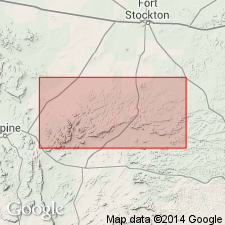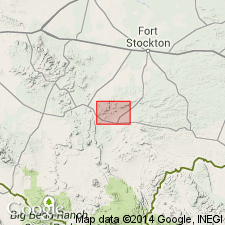
- Usage in publication:
-
- Lenoxhills formation
- Modifications:
-
- First used
- Dominant lithology:
-
- Sandstone
- Conglomerate
- Limestone
- Shale
- AAPG geologic province:
-
- Permian basin
Summary:
First used. Two formations, Nealranch (base) and Lenoxhills (top) first used in this report as replacements for Wolfcamp formation of Udden (1917) in Wolfcamp type locality (Wolf Camp Hills, Glass Mountains, Brewster Co, TX in Permian basin). Intent to name not stated; probably named for Lenox Hills west of Marathon, Glass Mountains, where type section described. Composed of 130 ft of conglomerate at base succeeded by 160 ft of sandstone, clastic limestone, and shale. To southwest in Lenox Hills entire formation changes facies into conglomerate. Further to southwest at Dugout Mountain, the conglomerate changes into sandstone and shale (150 ft thick) and finally into limestone and shale. Throughout Glass Mountains Lenoxhills marked by consistent basal conglomerate, but strata above change facies within short distances. Lenoxhills unconformably overlies Nealranch and Gaptank formations, and older strata of Marathon orogenic belt; unconformably underlies Leonard formation in western Glass Mountains (this contact conformable in eastern mountains). "Nealranch formation embraces the upper part of beds originally called Wolfcamp by Udden (1917) in the Wolf Camp Hills and is renamed to retain this widely used name for the time-stratigraphic unit, the Wolfcamp Series. The Lenoxhills...is the upper formation of the Wolfcamp Series in the Glass Mountains." Permian (Wolfcamp) age. Composite stratigraphic section. Fossils drawn and discussed in detail.
Source: GNU records (USGS DDS-6; Denver GNULEX).

- Usage in publication:
-
- Lenox Hills Formation*
- Modifications:
-
- Revised
- AAPG geologic province:
-
- Permian basin
Summary:
Lenox Hills Formation of Ross (1959) revised in eastern Glass Mountains, Brewster Co, TX in Permian basin--authors include upper part of Ross' (1963) Lenox Hills Formation (from about 1 mi east of Hess Ranch house eastward) in Hess Formation, and suggest that the top of Lenox Hills Formation in eastern Glass Mountains be drawn at the top of the highest bed of conglomerate or calcirudite. The lower part of the revised Hess Formation is of Wolfcamp age, equivalent to part of the Lenox Hills Formation of the western part of the Glass Mountains.
Source: GNU records (USGS DDS-6; Denver GNULEX).
For more information, please contact Nancy Stamm, Geologic Names Committee Secretary.
Asterisk (*) indicates published by U.S. Geological Survey authors.
"No current usage" (†) implies that a name has been abandoned or has fallen into disuse. Former usage and, if known, replacement name given in parentheses ( ).
Slash (/) indicates name conflicts with nomenclatural guidelines (CSN, 1933; ACSN, 1961, 1970; NACSN, 1983, 2005, 2021). May be explained within brackets ([ ]).

